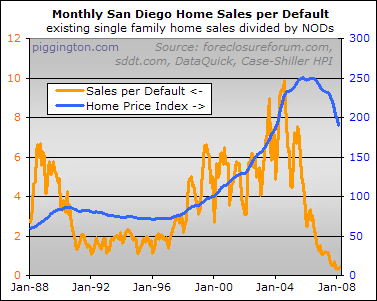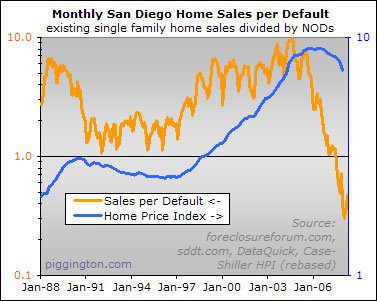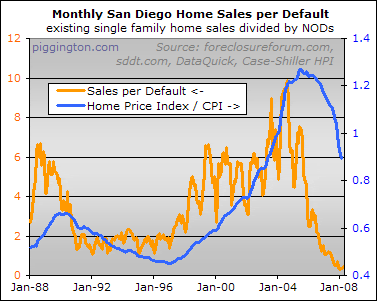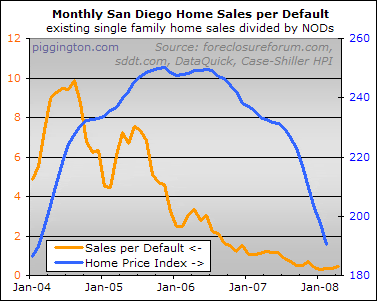Following up on April’s record-breaking foreclosure numbers, here is a look at how sales are stacking up against default notices:

The idea behind this chart is that NODs serve as a proxy for future must-sell inventory (or "phantom inventory," as ocrenter puts it). Comparing sales volume to the incidence of NODs provides kind of a rough measure of how much demand there is in addition to probable/future must-sell supply.
This seems to be a good indicator because peaks and troughs in the sales-per-default series have tended to lead those in the price series. Also, prices have pretty reliably fallen every time the sales-per-default ratio has fallen below 2.
In April the ratio was at .47. This is not the all-time low, but it’s close, and when taking seasonality into effect it was probably the worst month yet. It’s certainly a lot worse than anything we saw in the 1990s, where the ratio bounced between 1.25 and 2.25 for the most part.
Note that this number measures all NODs versus just single family home sales. This is purely based on the fact that I don’t have a long-term series for condo sales. It doesn’t matter, though, as SFR sales are just fine as a barometer of demand as long as the ratio is viewed relative to prior values rather than in absolute terms.
Even when condos are included, the total number of April existing sales was 2,475 homes, amounting to only 69 percent of April NODs. (New home sales should not be included here because they are their own type of must-sell inventory).
Here are some more charts for the visually oriented. First, the same thing using a logarithmic scale:

Next, the same data but with home prices adjusted for inflation.

Finally, a close-up of the data since 2004 (back to using nominal home prices). I chose 2004 because that was the year the ratio peaked, but I wanted to include the entire calendar year.

The April reduction in the month-of-inventory ratio was impressive and it brought a lot of bottom callers out of the woodwork, as can be seen in the latest U-T writeup. The comments to that article also featured a level of bullish chest-thumping that I haven’t seen for quite some time. But the fact is that even though demand picked up big time last month, it was still swamped by foreclosure activity. Demand is not keeping up with must-sell supply. I don’t expect much improvement in the aggregate housing market until the sales-per-default figure increases significantly.

April sales have a direct
April sales have a direct relation to the must-sale available in market in the month of April. NOD’s in April when they show up later (6-9..or whatever) should be stacked against the sale activity for the corresponding month when they show up. I think a graph of must sell/distress inventory against sales (not sure what to consider as sales ..sale pending, closed??) is whats needed to give any kind of rough measure. See how the demand improved considering Mira Mesa as the eg.